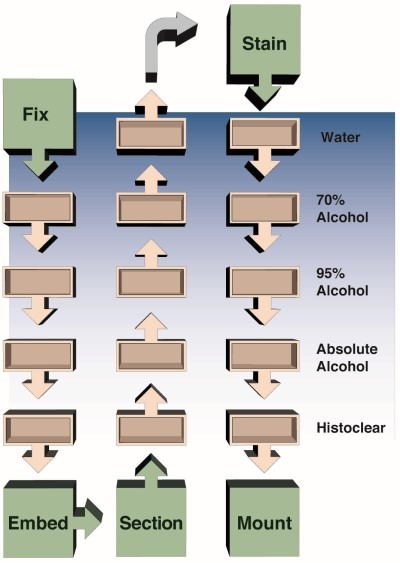Histology Fundamentals
Overview of the Paraffin Technique
Once fixed, the tissue must be treated to allow the cutting of the thin sections required for viewing under the microscope. The procedures designed to prepare the tissue for sectioning are collectively known as tissue processing. First, the sample is dehydrated by immersion in a series of aqueous alcohol solutions gradually moving to pure alcohol. The tissue is then soaked in an appropriate solvent to remove the alcohol. Finally the tissue is embedded in paraffin wax, which enables the cutting of sections of between 3 and 10 microns thickness. The movement through the series of baths in tissue processing occurs either by hand or by means of an automated processor. The table below gives a typical tissue schedule for an automated processor. The optimum protocol for any particular sample and apparatus may vary.
| Process Bath | 18 Hour Cycle (Time in Hours) | 24 Hour Cycle (Time in Hours) |
|---|---|---|
| 70% ethanol | 1.5 | 2 |
| 80% ethanol | 1.5 | 2 |
| 95% ethanol | 1.5 | 2 |
| Absolute alcohol | 1.5 | 2 |
| Absolute alcohol | 1.5 | 2 |
| Alcohol/Histo-Clear (v/V) | 1.5 | 2 |
| HIsto-Clear | 1.5 | 2 |
| Histo-Clear | 1.5 | 2 |
| Histo-Clear | 1.5 | 2 |
| Paraffin | 1.5 | 2 |
| Paraffin | 1.5 | 2 |
| Paraffin | 1.5 | 2 |

An overview of the complete process of tissue preparation for viewing by light microscopy, from fixation to mounting.
NEXT TOPIC: Suggested Procedures for Processing Fixed Tissue
- Working Safely with Fixatives
- The Chemistry of Dyes and Staining
- Suggested procedures for processing fixed tissue
- Staining Procedures
- Sectioning
- Overview of the Paraffin Technique
- Overview of Fixation
- Non-Aldehyde Fixatives
- Mounting Tissue Sections
- Factors Affecting Fixation
- Embedding
- Dehydration
- Decalcifying Tissue for Histological Processing
- Clearing Tissue Sections
- Artifacts in Histologic Sections
- Aldehyde Fixatives
